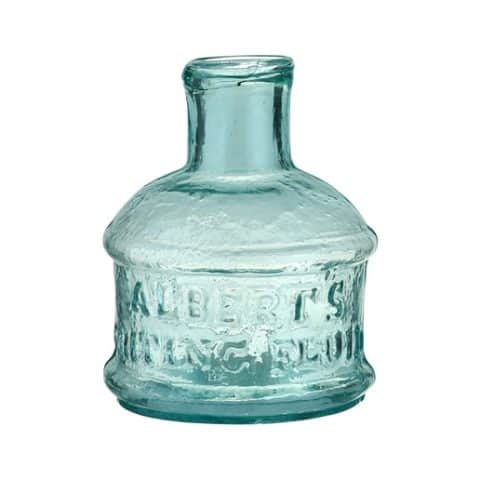Morgans Ink Pitts
Morgans Ink
Pitts
Probably Benjamin T. C. Morgan, Pittsburgh, Pennsylvania
Aquamarine Multi-Sided Inkwell
Provenance: Chip Cable Collection

Our aquamarine multi-sided “Morgans Ink Pitts” is extremely rare. The consignor notes that he bought this example at a local auction when he moved to the Pittsburgh area in 2008 and that it is the only whole example he has ever seen. He also said they dug a broken Morgans’ Ink in the 1980s.

The crude 12-sided, 3-inch tall, cylindrical inkwell has embossed sans serif copy on two lines and places individual letters on each panel. The top line reads ‘MORGANS’ on seven successive vertical panels. The five following upper panel areas are blank. The copy ‘INK PITTS’ is on the second or lower line. “Ink” starts beneath the “R” of “Morgan.” There is an open space and then “Pitts” occurs aligned beneath five open panels on the reverse. The inkwell shoulders are slightly curved, connecting to a slightly tapered neck, terminating with a lip tooled to give a narrow-collar effect. The inkwell bottom has a blowpipe pontil scar. The condition and character are excellent.

In colonial America, literacy was growing though writing letters was somewhat expensive when you included mailing. There was, however, a broad market and need for ink for diaries and books. Commercially manufactured ink was sold by printers, stationery and bookshop keepers, and even libraries. The ink bottles and inkwells were made by American glasshouses that used French, British, or India ink manufactured for distribution and imported to America.
In Pittsburgh, Pennsylvania, at about the same time, Arnold’s Chemical Writing Fluid advertisements peppered newspaper pages with reports of new ink imports from London. Bottles were being sold in two sizes at book and paper stores. By the mid-1840s, Hibbert’s Chemical Writing Fluid was sold in various bottle sizes at B. A. Fahnestock & Co. at the corner of 1st and Wood Streets.
In 1854, in the Pittsburgh Gazette, S. B. Lauffer at 87 Wood Street announced that he was selling a wide variety of inks such as Arnold’s Writing Fluid (black and carmine inks), Blackwood & Co’s superior steel pen ink, Walkden’s British ink, and powder, Harrison’s Columbian inks (black and red, scarlet and carmine), Warren & Co.’s Congress inks, Estel & Co.’s black inks for steel pens, Guyot’s French carmine ink, and Fitzpatrick & Co.’s black ink, together with a large lot of other inks. We suspect one of the “other” inks was Morgan’s Ink, which may not have had the name or brand appeal to compete with the more widely known and popular inks.
See the museum example of an Albert’s Writing Fluid Pitts Pa ink bottle.
Benjamin T. C. Morgan
B. T. C. Morgan, as he was listed in early Pittsburgh city directories, was born in New York around 1811. Information lists him as a clerk in the 1840s. By 1852 he was listed as a stationer at 104 Wood Street and owning a book store in 1857 at 41 Fifth Avenue.
Interestingly, other “Morgans” were merchants on Wood Street in the late 1840s and 1850s, like George Morgan & Co. (George Morgan and Waterman Palmer). They were wholesale grocers across the street from Benjamin Morgan at 105 Wood Street. John D. Morgan was a wholesale and retail druggist, and dealer in dye-stuffs, paints, oils, varnishes, etc. at No. 93 Wood Street, and John T. Morgan was a looking glass manufacturer at 98 Wood. They all lived close by on Diamond Alley, suggesting a family relationship. John D. Morgan, the druggist, was responsible for the extremely rare aquamarine “Morgans Rheumatic Liniment” rectangle and the aquamarine “Morgans Worm Killer” cylinder bottles.
Primary Image: Morgans Ink Pitts inkwell imaged on location by Alan DeMaison, FOHBC Virtual Museum Midwest Studio.
Support Image: Ink bottles blown in full-size two-piece molds, mid-late 19th century, Collection of William E. Covill, Jr. – American Bottles and Flasks and Their Ancestry by Helen McKearin and Kenneth M. Wilson, Crown Publishers, New York, 1978. Additional reference to American Bottles and Flasks and Their Ancestry by Helen McKearin and Kenneth M. Wilson, Crown Publishers, New York, 1978.
Support: Reference to Ink Bottles and Inkwells, William F. Covill, Jr., 1971
Join the FOHBC: The Virtual Museum is a project of the Federation of Historical Bottle Collectors (FOHBC). To become a member.


























